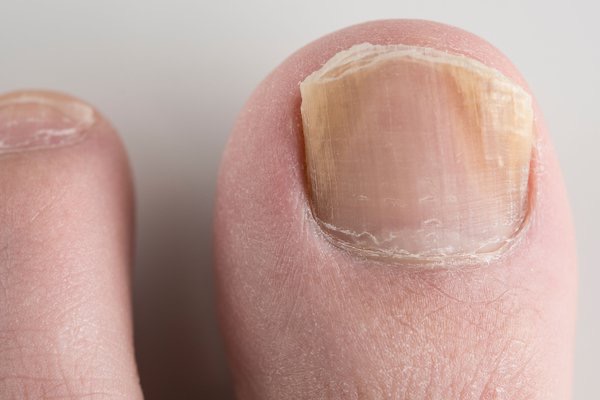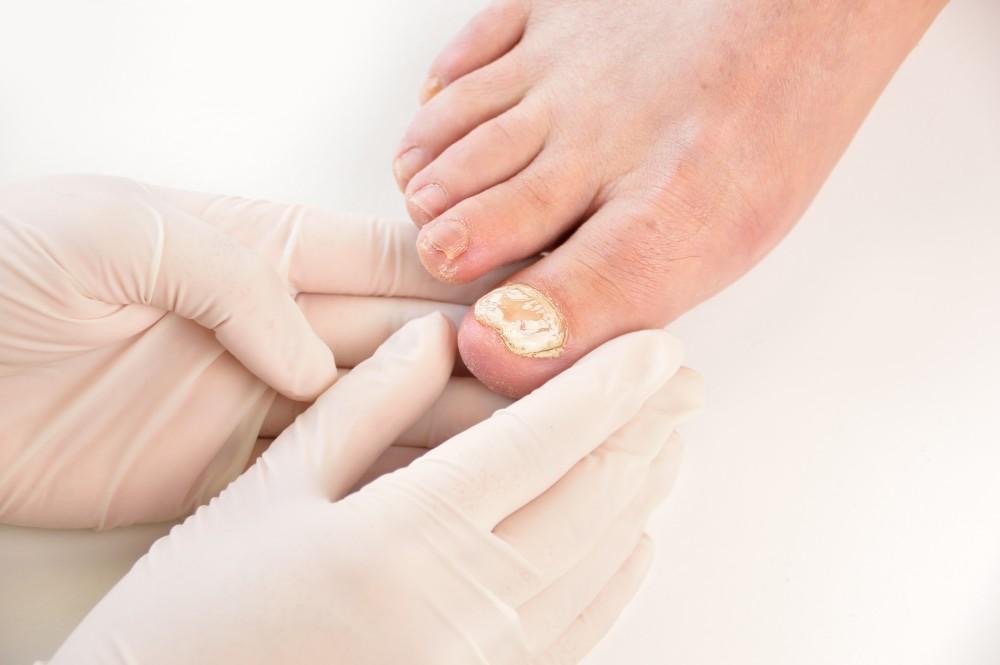Toenail fungus, a condition known scientifically as onychomycosis, is a common nail disorder. It’s primarily caused by a threesome of unwanted guests: dermatophytes, moulds, or yeasts. These pesky troublemakers can invade and infect the nail bed, matrix, and plate of the nail, leading to noticeable alterations in your nail’s appearance.
You might observe changes to the shape of your nail or shifts in its natural colour. Some may even experience a drastic overall difference in the aesthetic appeal of the affected nail. But remember, while the sight of a fungal nail infection might wrinkle your nose, it’s one of the most widespread nail disorders around.
Key Questions Addressed in this Article:
- What is a fungal toenail infection, and what are its different types?;
- What are the causes of fungal toenail infections?;
- Who is at risk of developing fungal toenail infections?;
- What are the common symptoms of fungal toenail infections?;
- How can fungal toenail infections be prevented effectively?
Understanding Nail Fungal Infections: Causes and Varieties
Toenail fungus, scientifically referred to as onychomycosis, is a widespread and often unsightly nail condition resulting from fungal intrusion into the nail structure. This intrusive fungus could result from different sources, such as shared spaces like public swimming pools and other humid environments, non-sterile nail grooming tools, or coming into physical contact with an infected individual. It’s crucial to note that this condition has a higher incidence rate in toenails than fingernails – with the environment inside shoes providing the ideal conditions (warm, dark and moist) for this fungus to prosper.
Examining the Diverse Forms of Fungal Nail Infections
Interestingly, fungal nail infections don’t always manifest in the same way—in fact, there are five primary categories of these infections, differentiated by their physical characteristics:
- Distal Lateral Subungual Onychomycosis (DLSO): This happens to be the most common manifestation of toenail fungus. In DLSO, the fungus initiates its invasion from the skin around the nail, penetrating the lower side of the nail plate via its free edge, eventually reaching the nail matrix. The consequence of this is often an abnormal skin thickening, known as subungual hyperkeratosis, which elevates the nail plate, frequently causing a yellowish discoloration;
- White Superficial Onychomycosis (WSO): A less frequently encountered type, WSO is characterized by fungal colonies localized on the upper surface of the nail plate. This might seem superficial initially; however, the fungal infection can penetrate the nail plate, extending to the nail fold and cuticle proximally, and usually presents as a white, chalky appearance;
- Proximal Subungual Onychomycosis (PSO): This particular type infiltrates the nail plate’s plantar aspect from the proximal end and spreads distally. It typically results in a white patch on the nail and might indicate an underlying compromised immune system, although it’s a relatively rare form;
- Endonyx Onychomycosis: This manifestation of nail fungus directly assaults the nail plate. One distinctive feature of this type is the absence of skin thickening between the nail and the nail bed, presenting instead as a milky white discoloration on the nail;
- Total Dystrophic Onychomycosis (TDO): Typically a result of chronic, untreated fungal infections, TDO is characterized by a complete loss of nail structure, resulting in a thick, deformed nail. TDO is commonly seen in individuals with congenital immunodeficiencies.
Notably, while most fungal infections can be placed into these five categories, it’s not rare for individuals to have mixed-pattern fungal infections. And because of these diverse patterns, a fungal nail infection can often be confused with other nail disorders or merely seen as a discoloured, thickened toenail.
The Risk Factor of Fungal Nail Infections and How to Identify Them
While fungal nail infections have a widespread incidence across various ages and ethnicities, certain demographics show a higher predisposition. Men, for instance, are more likely to experience a fungus-infected nail compared to women, and in terms of age, adults are more frequently affected than children.
Who’s More Likely to Get a Fungal Nail Infection?
Certain risk factors can enhance your vulnerability to nail fungus. These include:
- Advanced Age: Individuals above the age of 65 have higher susceptibility due to factors like diminished blood circulation and longer exposure to fungi;
- Shellac Use: Frequent use of shellac can weaken nails over time, making them more disposed to infections;
- Subpar Hygiene Practices: Using non-sterile equipment, especially if it has been in contact with an infected nail, heightens the risk;
- Public Spaces: Locations with high humidity like public pools and changing rooms are hotbeds for fungus growth;
- Tight Footwear: Shoes that are too tight can cause minor nail injuries through which fungus can invade;
- Existing Nail Trauma: Any pre-existing nail injuries make the nail more susceptible to fungal infections;
- Physical Deformities: Certain foot deformities can predispose an individual to these infections;
- Certain Sporting Activities: Sports like running and swimming that keep your feet damp for extended periods can increase the foot’s exposure to fungi;
- Pre-existing Medical Conditions: Conditions like diabetes, HIV, or tinea pedis (a fungal infection on the foot’s skin) can make an individual more prone to fungal nail infections;
- Weakened Immune System: Being immunocompromised or having peripheral arterial disease can make it easier for a fungal nail infection to take hold;
- Obesity: Obesity can increase the risk of developing toenail fungus;
- Smoking: Smoking can reduce blood circulation in the extremities, making them more vulnerable to infections like toenail fungus.
Identifying a Fungal Nail Infection
Professionals like podiatrists are skilled in identifying the signs of a fungal nail infection. Here’s what they’ll typically look for:
- Nail Discoloration: Fungal infection usually causes a change in nail color, typically to a yellowish or white hue;
- Nail Deformities: Look out for thickening or brittleness of the nail and debris buildup under the nail;
- Nail Detachment: Look out for signs of the nail lifting from the nail bed;
- Nail Trauma: Any recent or existing nail injuries could allow fungus to invade the nail;
- Unpleasant Odor: Fungal infections often bring a foul odor;
- Moisture in Footwear: Excess moisture in the shoes can promote fungus growth.
While these are common signs of a fungal infection, it’s important not to confuse them with symptoms of other nail conditions, such as psoriasis, that could present similarly.

Addressing Fungal Nail Infections: A Comprehensive Treatment Guide
Before embarking on any treatment plan for fungal nail infections, it’s imperative to consult a podiatrist. Several factors influence the choice of treatment, including the type of fungus identified, the susceptibility to antifungal medications, accompanying health conditions, potential drug interactions, dietary considerations, age, compliance, and affordability.
Let’s delve deeper into some of the common treatment strategies:
1. Photodynamic Antimicrobial Therapy (PACT)
PACT is a proven and fail-safe treatment for fungal nails. It works by using light to activate photosensitive agents, permeating the cell walls of the microorganisms. The elegance of PACT lies in its ability to destroy the infecting cells while leaving the healthy tissue unscathed. The treatment typically spans three sessions.
A 2016 study by Figueiredo et al. demonstrated a 100% success rate with PACT for mild to moderate fungal infections and a 63.5% success rate for severe conditions.
A PACT treatment plan might include:
- Initial consultation: Fungal diagnosis, chemical and mechanical debridement, additional foot care if needed, supply of urea and dressing for home use, provision of tinea cream or spray, and imparting knowledge about fungal nail infection and environmental factors;
- Follow-up consultations: Mechanical debridement, application of gel, PACT laser therapy, and continuation of home treatment and good foot habits. These consultations might also include a ‘shoe zap’ for shoe disinfection;
- Final consultation: Treatment progress review to ensure healthy nail growth.
2. Oral Medications
Systemic or oral treatments are suitable for all kinds of fungal infections. These prescription medications require careful discussion about the patient’s medical history, potential side effects, and adverse reactions with a general practitioner. Regular liver function tests are recommended to monitor for adverse effects in susceptible individuals.
Oral treatments may be taken for several months until definitive results are achieved. They boast an approximate 85% success rate but can cause side effects such as dizziness, headaches, and skin rashes.
3. Topical Nail Paints
Over-the-counter medications like ciclopirox nail lacquer, amorolfine nail lacquer (Loceryl), and Canesten are handy topical treatments. They are best used when the nail matrix is not affected. The nail is filed down and coated with the selected lacquer, allowing the active ingredient to seep into the affected nail.
Their efficacy rate averages around 8-10%, and treatment can span from 6 to 24 months for visible improvement. It’s recommended to schedule podiatry appointments every six weeks during this period to ensure sterile instrument use and effective mechanical nail debridement, enhancing the effectiveness of the topical agents.
Prevention
Maintain Good Foot Hygiene
Regularly washing and drying the feet thoroughly, especially between the toes, can help prevent fungal growth.
Wear Breathable Footwear
Opt for shoes made of breathable materials to reduce moisture and create an inhospitable environment for fungi.
Avoid Going Barefoot in Public Areas
Minimize direct contact with potentially contaminated surfaces, such as communal showers or swimming pool areas.
Use Antifungal Powders or Sprays
Applying antifungal products to the feet and inside shoes can help prevent fungal growth and reinfection.
Trim Nails Carefully
Keeping nails trimmed and filed can reduce the risk of trauma and create fewer opportunities for fungi to invade.
Regularly Replace Footwear and Socks
Old or worn-out footwear and socks can harbor fungi, so it’s important to replace them regularly.
By incorporating these preventive measures into daily routines, individuals can significantly reduce their risk of developing fungal toenail infections.
Conclusion
Understanding the types of toenail fungus, their causes, symptoms, treatment options, and preventive strategies is crucial for effectively managing and minimizing the impact of fungal nail infections. By recognizing the signs early and seeking appropriate care, individuals can address these infections promptly, leading to improved nail health and overall well-being. Additionally, adopting preventive measures can help reduce the risk of future fungal nail infections, promoting long-term foot health and comfort.


